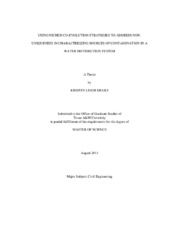| dc.description.abstract | Threat management of water distribution systems is essential for protecting consumers. In a contamination event, different strategies may be implemented to protect public health, including flushing the system through opening hydrants or isolating the contaminant by manipulating valves. To select the most effective options for responding to a contamination threat, the location and loading profile of the source of the contaminant should be considered. These characteristics can be identified by utilizing water quality data from sensors that have been strategically placed in a water distribution system. A simulation-optimization approach is described here to solve the inverse problem of source characterization, by coupling an evolutionary computation-based search with a water distribution system model. The solution of this problem may reveal, however, that a set of non-unique sources exists, where sources with significantly different locations and loading patterns produce similar concentration profiles at sensors. The problem of non-uniqueness should be addressed to prevent the misidentification of a contaminant source and improve response planning. This paper aims to address the problem of non-uniqueness through the use of Niched Co-Evolution Strategies (NCES). NCES is an evolutionary algorithm designed to identify a specified number of alternative solutions that are maximally different in their decision vectors, which are source characteristics for the water distribution problem. NCES is applied to determine the extent of non-uniqueness in source characterization for a virtual city, Mesopolis, with a population of approximately 150,000 residents. Results indicate that NCES successfully identifies non-uniqueness in source characterization and provides alternative sources of contamination. The solutions found by NCES assist in making decisions about response actions. Once alternative sources are identified, each source can be modeled to determine where the vulnerable areas of the system are, indicating the areas where response actions should be implemented. | en |


